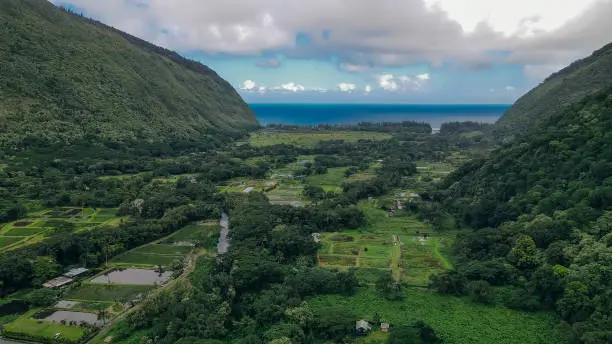Nestled in the heart of the Pacific Ocean, more than 2,000 miles from the nearest continent, Hawaii is the most isolated island chain on Earth. Yet despite this remarkable remoteness, the Aloha State has cultivated a unique blend of natural beauty, cultural richness, and modern innovation. Hawaii’s geographic isolation poses undeniable challenges — from supply chain logistics to economic dependence — but it has also forged a resilient spirit that defines both its people and its progress.
An Island Born of Fire and Distance
Hawaii’s story begins with isolation itself. Formed by volcanic activity millions of years ago, the islands rose from the ocean as barren rock, far from any mainland influence. Over time, seeds carried by birds, winds, and waves transformed these remote peaks into lush ecosystems filled with species found nowhere else on Earth. This ecological solitude became a symbol of endurance — life thriving in the middle of the sea against all odds.
That same principle of resilience extends to human settlement. Ancient Polynesians navigated thousands of miles across the Pacific using only the stars, ocean currents, and birds to guide them. Their successful arrival and adaptation to this isolated land stand as a powerful testament to ingenuity and survival — qualities that still define Hawaii today.
Cultural Strength in Separation
Hawaii’s isolation helped preserve one of the world’s most distinct cultural heritages. Long before Western contact, Native Hawaiians developed a complex society with a deep connection to the land and sea. The isolation allowed traditions like hula, chant, and the Hawaiian language to evolve independently, forming a cultural identity rooted in self-reliance and community.
Even after global influences reached its shores, Hawaii’s people have maintained a strong sense of unity through the value of aloha — a concept that extends beyond simple greetings to embody compassion, mutual respect, and harmony. In a place so distant from the rest of the world, community is everything. This cultural resilience has not only preserved native traditions but also created a melting pot of influences that makes modern Hawaii both diverse and inclusive.
Economic Ingenuity: Turning Distance into Distinction
While isolation can limit trade and drive up costs, Hawaii has learned to adapt its economy to its surroundings. Tourism remains a cornerstone of its success, drawing millions each year who are eager to experience the islands’ unmatched natural beauty and hospitality. However, reliance on tourism alone isn’t enough for long-term stability. Recognizing this, Hawaii has embraced diversification through innovation and sustainability.
The state has become a leader in renewable energy, capitalizing on abundant sunlight, ocean winds, and geothermal activity. Hawaii’s goal of achieving 100% renewable energy by 2045 demonstrates its commitment to self-sufficiency — a modern expression of the same resilience that sustained its ancestors. Local agriculture and aquaculture are also gaining momentum as communities strive to reduce dependence on imported goods. From farm-to-table initiatives to the revival of traditional fishponds (loko i‘a), Hawaii is investing in sustainable systems that honor its past while preparing for the future.
Overcoming Modern Challenges
Of course, Hawaii’s isolation still brings significant challenges. Nearly 90% of the state’s food is imported, leaving it vulnerable to supply disruptions and rising costs. Housing shortages, high living expenses, and limited land availability compound these issues. Yet the same determination that enabled early settlers to cross oceans continues to drive solutions today.
Local entrepreneurs are pioneering innovations in shipping logistics to Hawaii, clean technology, and digital connectivity. The rise of remote work has also opened new possibilities, allowing professionals to live and contribute from the islands without being bound to mainland offices. In education and healthcare, telecommunication advancements are bridging distances once thought insurmountable.
Community initiatives further strengthen resilience. Grassroots movements focusing on sustainability, cultural preservation, and environmental stewardship have gained momentum across the islands. Whether it’s restoring native forests, cleaning beaches, or revitalizing the Hawaiian language, these collective efforts reflect a deep-rooted belief that thriving in isolation requires everyone’s participation.
The Future of an Island Nation
As the world faces increasing uncertainty — from climate change to global supply chain disruptions — Hawaii offers a powerful example of how isolation can be a source of strength rather than limitation. Its small size and distance from global centers have forced innovation, encouraged collaboration, and reinforced the value of sustainability.
The islands’ future depends on continuing this balance — honoring cultural traditions while embracing technological and environmental progress. Efforts to increase food security, expand renewable energy, and nurture local industries will be essential to ensure that Hawaii’s prosperity endures for generations to come.
In Conclusion
Hawaii’s geographic isolation could easily have been its greatest weakness. Instead, it became the foundation of its strength. The islands’ history, culture, and economy all reflect a profound resilience — one born from necessity, sustained by community, and inspired by nature.
From the Polynesian voyagers who first charted its waters to the modern innovators shaping its future, Hawaii’s story is one of adaptation, unity, and perseverance. Surrounded by ocean yet deeply connected to the world, Hawaii stands as a shining example of remote resilience — proof that even in isolation, life can not only endure but flourish.
Also Read- How Quick Home Sales Are Changing the Real Estate Landscape







